之前本博客写了一篇关于模拟点击的文章,现在来简单了解一下。 以下是官方的说明文档: /** * Base class for implementing application instrumentation code. When running * with instrumentation turned on, this class will be instantiated for you * before any of the application code, allowing you to monitor all of the * interaction the system has with the application. An Instrumentation * implementation is described to the system through an AndroidManifest.xml's * tag. */
大致意思是:在任何应用程序代码之前,允许您监视所有的与应用程序的交互。就是监测你当前的程序。Instrumentation和Activity有点类似,只不过Activity是需要一个界面的,而Instrumentation并不是这样的,我们可以将它理解为一种没有图形界面的,具有启动能力的,用于监控其他类(用Target Package声明)的工具类。
下面通过一个简单的例子来讲解Instrumentation的基本测试方法。
1.首先建立一个Android project,类名为Sample,代码如下:
这个程序的功能比较简单,点击按钮之后,TextView的内容由Hello变为Hello Android.同时,在这个类中,我还写了一个简单的add方法,没有被调用,仅供测试而已。
2. 在src文件夹中添加一个测试包,在测试包中添加一个测试类SampleTest
测试类的代码如下:
下面来简单讲解一下代码: setUp()和tearDown()都是受保护的方法,通过继承可以覆写这些方法。
在android Developer中有如下的解释 protected void setUp () Since: API Level 3 Sets up the fixture, for example, open a network connection. This method is called before a test is executed.
protected void tearDown () Since: API Level 3 Make sure all resources are cleaned up and garbage collected before moving on to the next test. Subclasses that override this method should make sure they call super.tearDown() at the end of the overriding method.
setUp ()用来初始设置,如启动一个Activity,初始化资源等。 tearDown ()则用来垃圾清理与资源回收。
在testActivity()这个测试方法中,我模拟了一个按钮点击事件,然后来判断程序是否按照预期的执行。在这里PerformClick这个方法继承了Runnable接口,通过新的线程来执行模拟事件,之所以这么做,是因为如果直接在UI线程中运行可能会阻滞UI线程。
2.要想正确地执行测试,还需要修改AndroidManifest.xml这个文件.
经过以上步骤,下面可以开始测试了。测试方法也有以下几种,下面介绍两个常用的方法:
(1) 用Eclipse集成的JUnit工具 在Eclipse中选择工程Sample,单击右键,在Run as子菜单选项中选择Android JUnit Test
同时可以通过LogCat工具查看信息
(2) 通过模拟器运行单元测试
点击模拟器界面的Dev Tools菜单
再点击Instrumentation选项,进入Instrumentation菜单
这里有一个InstrumentationTestRunner,它是测试的入口,点击这个选项,就可以自动运行我们的测试代码。以下为运行结果:
按钮点击前
按钮点击后
至此,一个简单的测试过程结束了。当然,android的测试内容还有很多,也有比较复杂的,我会在以后的学习过程中继续分享我的体会。
大致意思是:在任何应用程序代码之前,允许您监视所有的与应用程序的交互。就是监测你当前的程序。Instrumentation和Activity有点类似,只不过Activity是需要一个界面的,而Instrumentation并不是这样的,我们可以将它理解为一种没有图形界面的,具有启动能力的,用于监控其他类(用Target Package声明)的工具类。
下面通过一个简单的例子来讲解Instrumentation的基本测试方法。
1.首先建立一个Android project,类名为Sample,代码如下:
package com.hustophone.sample;
import android.app.Activity;
import android.os.Bundle;
import android.view.View;
import android.view.View.OnClickListener;
import android.widget.Button;
import android.widget.TextView;
public class Sample extends Activity {
private TextView myText = null;
private Button button = null;
@Override
public void onCreate(Bundle savedInstanceState) {
super.onCreate(savedInstanceState);
setContentView(R.layout.main);
myText = (TextView) findViewById(R.id.text1);
button = (Button) findViewById(R.id.button1);
button.setOnClickListener(new OnClickListener() {
@Override
public void onClick(View arg0) {
myText.setText("Hello Android");
}
});
}
public int add(int i, int j) {
return (i + j);
}
}这个程序的功能比较简单,点击按钮之后,TextView的内容由Hello变为Hello Android.同时,在这个类中,我还写了一个简单的add方法,没有被调用,仅供测试而已。
2. 在src文件夹中添加一个测试包,在测试包中添加一个测试类SampleTest
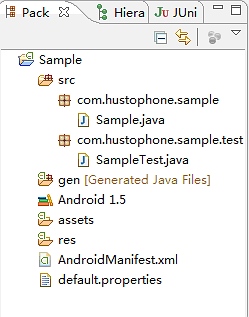
测试类的代码如下:
package com.hustophone.sample.test;
import com.hustophone.sample.R;
import com.hustophone.sample.Sample;
import android.content.Intent;
import android.os.SystemClock;
import android.test.InstrumentationTestCase;
import android.util.Log;
import android.widget.Button;
import android.widget.TextView;
public class SampleTest extends InstrumentationTestCase {
private Sample sample = null;
private Button button = null;
private TextView text = null;
/*
* 初始设置
* @see junit.framework.TestCase#setUp()
*/
@Override
protected void setUp() {
try {
super.setUp();
} catch (Exception e) {
e.printStackTrace();
}
Intent intent = new Intent();
intent.setClassName("com.hustophone.sample", Sample.class.getName());
intent.setFlags(Intent.FLAG_ACTIVITY_NEW_TASK);
sample = (Sample) getInstrumentation().startActivitySync(intent);
text = (TextView) sample.findViewById(R.id.text1);
button = (Button) sample.findViewById(R.id.button1);
}
/*
* 垃圾清理与资源回收
* @see android.test.InstrumentationTestCase#tearDown()
*/
@Override
protected void tearDown() {
sample.finish();
try {
super.tearDown();
} catch (Exception e) {
e.printStackTrace();
}
}
/*
* 活动功能测试
*/
public void testActivity() throws Exception {
Log.v("testActivity", "test the Activity");
SystemClock.sleep(1500);
getInstrumentation().runOnMainSync(new PerformClick(button));
SystemClock.sleep(3000);
assertEquals("Hello Android", text.getText().toString());
}
/*
* 模拟按钮点击的接口
*/
private class PerformClick implements Runnable {
Button btn;
public PerformClick(Button button) {
btn = button;
}
public void run() {
btn.performClick();
}
}
/*
* 测试类中的方法
*/
public void testAdd() throws Exception{
String tag = "testAdd";
Log.v(tag, "test the method");
int test = sample.add(1, 1);
assertEquals(2, test);
}
}下面来简单讲解一下代码: setUp()和tearDown()都是受保护的方法,通过继承可以覆写这些方法。
在android Developer中有如下的解释 protected void setUp () Since: API Level 3 Sets up the fixture, for example, open a network connection. This method is called before a test is executed.
protected void tearDown () Since: API Level 3 Make sure all resources are cleaned up and garbage collected before moving on to the next test. Subclasses that override this method should make sure they call super.tearDown() at the end of the overriding method.
setUp ()用来初始设置,如启动一个Activity,初始化资源等。 tearDown ()则用来垃圾清理与资源回收。
在testActivity()这个测试方法中,我模拟了一个按钮点击事件,然后来判断程序是否按照预期的执行。在这里PerformClick这个方法继承了Runnable接口,通过新的线程来执行模拟事件,之所以这么做,是因为如果直接在UI线程中运行可能会阻滞UI线程。
2.要想正确地执行测试,还需要修改AndroidManifest.xml这个文件.
经过以上步骤,下面可以开始测试了。测试方法也有以下几种,下面介绍两个常用的方法:
(1) 用Eclipse集成的JUnit工具 在Eclipse中选择工程Sample,单击右键,在Run as子菜单选项中选择Android JUnit Test
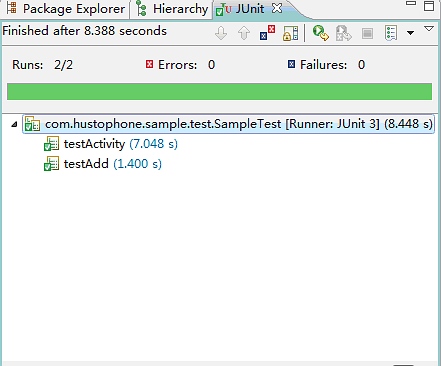
同时可以通过LogCat工具查看信息
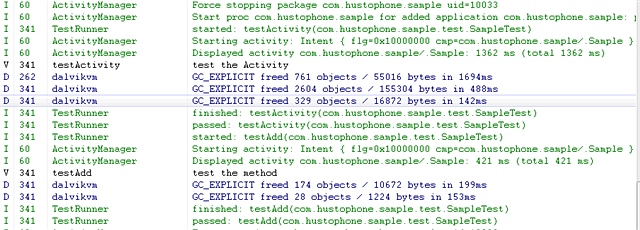
(2) 通过模拟器运行单元测试
点击模拟器界面的Dev Tools菜单

再点击Instrumentation选项,进入Instrumentation菜单

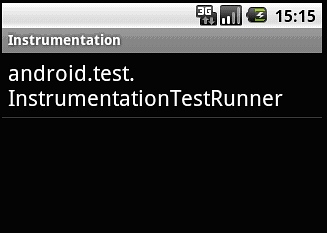
这里有一个InstrumentationTestRunner,它是测试的入口,点击这个选项,就可以自动运行我们的测试代码。以下为运行结果:
按钮点击前
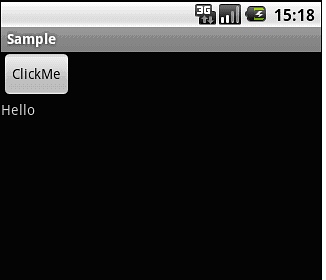
按钮点击后
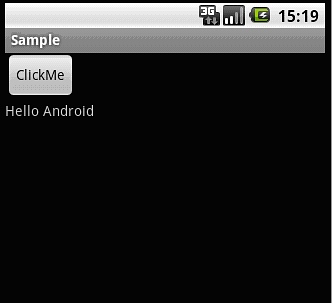
至此,一个简单的测试过程结束了。当然,android的测试内容还有很多,也有比较复杂的,我会在以后的学习过程中继续分享我的体会。
收藏的用户(0) X
正在加载信息~
推荐阅读
最新回复 (0)
站点信息
- 文章2305
- 用户1336
- 访客11442099
每日一句
All advantages aren't in running quickly, but in getting a head start.
优势不在于跑得快,而在于起身早。
优势不在于跑得快,而在于起身早。
 转载一篇微信WEB端接口说明
转载一篇微信WEB端接口说明 P2P中NAT之间的打洞可能性
P2P中NAT之间的打洞可能性 语法错误: 意外的令牌“标识符”
语法错误: 意外的令牌“标识符” 发几个实用的chrome插件
发几个实用的chrome插件 jQuery的load方法Cannot read property 'indexOf' of undefined
jQuery的load方法Cannot read property 'indexOf' of undefined IDEA创建SpringBoot项目详细步骤
IDEA创建SpringBoot项目详细步骤 MPAndroidChart最新版时间X轴例子
MPAndroidChart最新版时间X轴例子 独家发布最新可用My-AutoPost——wordpress 采集器
独家发布最新可用My-AutoPost——wordpress 采集器 linux下C/C++网络编程基本:socket实现tcp和udp的例子
linux下C/C++网络编程基本:socket实现tcp和udp的例子 【转载】cocos2d-x 3.0 制作横版格斗游戏
【转载】cocos2d-x 3.0 制作横版格斗游戏 Android反编译工具及方法(持续更新中)
Android反编译工具及方法(持续更新中) 微信小程序,一个有局限的类似 React Native 轮子!
微信小程序,一个有局限的类似 React Native 轮子! 使用VS Code断点调试Vue代码
使用VS Code断点调试Vue代码
新会员